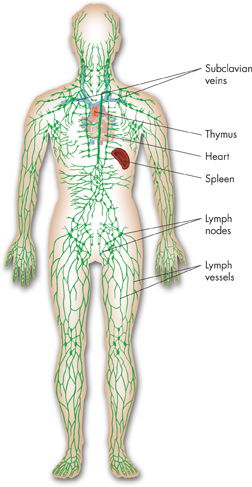Role in Nutrient Absorption The lymphatic system also plays an important role in the absorption of nutrients. A system of lymph vessels runs alongside the intestines. The vessels pick up fats and fat-soluble vitamins from the digestive tract and transport these nutrients into the bloodstream.
Role in Immunity Hundreds of small bean-shaped enlargements—called lymph nodes—are scattered along lymph vessels throughout the body. Lymph nodes act as filters, trapping microorganisms, stray cancer cells, and debris as lymph flows through them. Fleets of white blood cells inside lymph nodes engulf or otherwise destroy this cellular “trash.” When large numbers of microorganisms are trapped in lymph nodes, the nodes become enlarged. The “swollen glands” that are symptoms of certain kinds of infections are actually swollen lymph nodes.
The thymus and spleen also play important roles in the immune functions of the lymphatic system. The thymus is located beneath the sternum. T lymphocytes mature in the thymus before they can function in the immune system. The functions of the spleen are similar to those of lymph nodes. However, instead of lymph, blood flows through the spleen, where it is cleansed of microorganisms and other debris. The spleen also removes old or damaged blood cells and stores platelets.
 In Your Notebook Compare and contrast the functions of the circulatory system and the lymphatic system.
In Your Notebook Compare and contrast the functions of the circulatory system and the lymphatic system.

FIGURE 33–10 The Lymphatic System The lymphatic system is a network of vessels, nodes, and organs that recycles fluids from tissues and plays a role in nutrient absorption and immunity. Infer Why do you think your doctor feels your neck for swollen lymph nodes when you are sick?
dCirculatory System Diseases
 What are three common circulatory diseases?
What are three common circulatory diseases?
Diseases of the circulatory system can progress for many years before they are discovered. Often the first sign of circulatory problems is an event that affects the heart or brain. Why? Tissues in these vital organs begin to die within moments if their oxygen supply is interrupted.  Three common and serious diseases of the circulatory system are heart disease, stroke, and high blood pressure. Damage to heart muscle from a heart attack or to the brain from a stroke can be fatal. Individuals with high blood pressure are at higher risk for both heart disease and stroke. Heart disease is the leading cause of death in the United States.
Three common and serious diseases of the circulatory system are heart disease, stroke, and high blood pressure. Damage to heart muscle from a heart attack or to the brain from a stroke can be fatal. Individuals with high blood pressure are at higher risk for both heart disease and stroke. Heart disease is the leading cause of death in the United States.
Table of Contents
- Formulas and Equations
- Applying Formulas and Equations
- Mean, Median, and Mode
- Estimation
- Using Measurements in Calculations
- Effects of Measurement Errors
- Accuracy
- Precision
- Comparing Accuracy and Precision
- Significant Figures
- Calculating With Significant Figures
- Scientific Notation
- Calculating With Scientific Notation
- Dimensional Analysis
- Applying Dimensional Analysis




